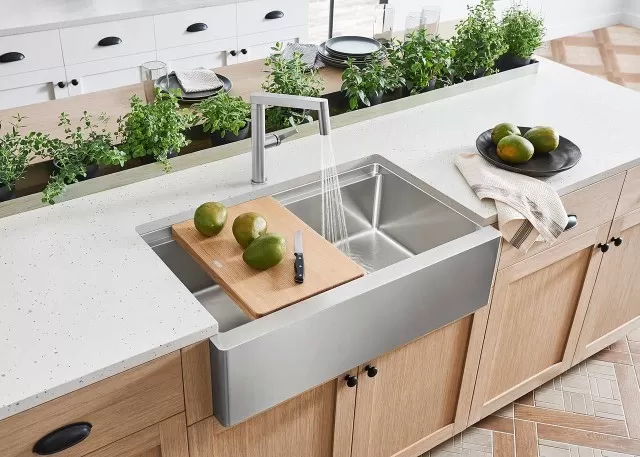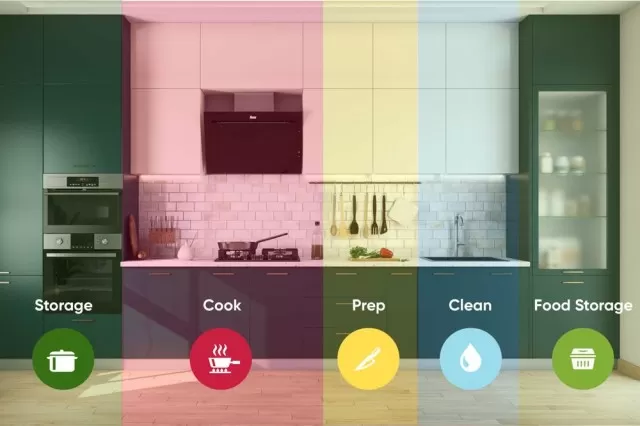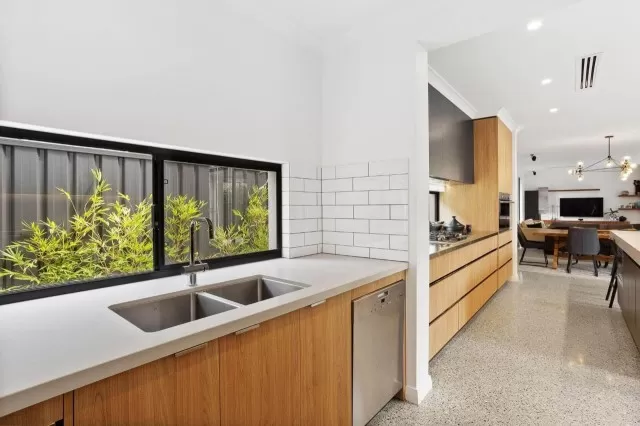Kitchen Countertop Zones: Efficient organization tips. Create a versatile and appealing kitchen with the perfect blend of functionality and style.
In today’s fast-paced world, families often seek practical solutions.
Modern design revolves around the idea of combining multiple functionalities within a single room. An effective solution is to divide the kitchen into distinct zones. Gone are the days when homeowners were confined to a traditional kitchen countertop. Nowadays, people are leveraging the advancements in the marketplace to adopt a “mix and match” approach, allowing them to achieve both the desired utility and aesthetic appeal for their kitchen.
Revamping Kitchen Spaces: Embracing Activity Zones

In the world of kitchen design, a revolution is underway.
Gone are the days of uniform countertops that serve only as functional work surfaces. Today, homeowners are discovering the power of creating kitchen activity zones that cater to their specific needs and preferences.
These zones are dynamic and versatile, accommodating a variety of tasks and transforming the traditional kitchen layout.
The once dominant concept of matching countertops is fading away, making room for a more eclectic and personalized approach.
Countertops are no longer limited to a singular purpose but instead are tailored to different activities that take place within the kitchen. Some countertops witness the daily hustle and bustle of family meal preparations and cleanup, while others become dedicated spaces for baking or fresh food preparation.
Certain countertops are designed to be eye-catching showpieces, while others seamlessly double as home offices, accommodating the needs of parents and children with ample space for phones, computers, and work materials.
Moreover, this newfound freedom extends beyond just countertops.
Even backsplashes, traditionally designed to match the countertop, are now part of the mix-and-match trend. Homeowners are embracing a bolder and more diverse range of colors, textures, and surfaces in their kitchen design, reflecting their individual styles and preferences.
According to Gin Guei Ebnesajjad, the manager of product styling and development at Dupont Surfaces, Corian, and Zodiaq, the guiding principle in modern kitchen planning and design is “the richer the mix, the better.
” This means that customers are actively seeking out combinations of colors, textures, and materials that harmonize with their specific requirements. The days of monotonous uniformity are giving way to a vibrant tapestry of possibilities.
In this era of kitchen design, activity zones are the key to creating a kitchen space that is not only visually appealing but also highly functional.
By integrating counters of varying heights and materials, homeowners can enhance the usability of their kitchen, catering to different tasks and creating a seamless workflow. Whether it’s a dedicated baking station with a marble countertop or a sturdy and spacious work area for kids to complete their homework, activity zones allow for versatility and customization like never before.
As the kitchen evolves into a hub of family life, the concept of activity zones is revolutionizing the way we design and use this vital space.
The days of uniform countertops and matching surfaces are long gone, replaced by a more eclectic and personalized approach. With the freedom to mix and match, homeowners can create a kitchen that is not only aesthetically pleasing but also perfectly tailored to their individual needs and lifestyle.
Embracing Design Fusion: Breaking Free from Uniform Countertops

In today’s kitchen design landscape, the concept of uniformity is being cast aside, making way for a more visually captivating and intricate aesthetic.
This trend is not limited to other areas of the home but has now found its place in the kitchen as well. Furniture-style cabinetry and customized countertops are becoming the norm, allowing each area to have its own distinct surface material and purpose.
The central island has emerged as a staple in modern kitchen layouts.
Its versatility knows no bounds, serving as a hub for food preparation, dining, or even a dedicated homework station. Similarly, counter peninsulas have become multifunctional spaces for baking, dining, and food preparation.
Countertops have evolved to offer a wide range of surfaces, heights, and customizable features, tailored to match any task at hand. They can be designed to be deeper than the standard, providing ample space, or can incorporate leg room for desk and dining areas.
The key to designing today’s multitasking kitchen counters lies in defining the specific tasks they will serve and applying creative solutions accordingly.
Gone are the days when countertops were merely functional surfaces.
The kitchen has transformed into a dynamic space that not only caters to culinary needs but also serves as a place for gathering, working, and creating memories. By breaking free from the constraints of uniformity, homeowners and designers are embracing the opportunity to infuse personality, functionality, and visual interest into the heart of the home.
Designing kitchen counters that can seamlessly accommodate various activities requires a combination of skill and creativity.
With an array of surface materials, heights, and customized additions, homeowners can create a kitchen that reflects their unique lifestyle and needs. Whether it’s a deeper countertop for a passionate baker or a specially designed area with leg space for a combined workspace and dining spot, the possibilities are limitless.
In the modern kitchen, uniformity has given way to a fusion of design elements that elevate the space into something truly extraordinary.
By embracing this newfound freedom, homeowners can transform their kitchens into captivating and functional environments that cater to their individual tastes and the demands of their daily lives. The era of uniform countertops is fading, making room for a new era of creativity, customization, and limitless possibilities.
Creating Functional Workspaces

In today’s kitchen design, designated workspaces have taken center stage, providing specialized areas for various tasks.
These workspaces are thoughtfully designed to enhance efficiency and convenience, catering to the specific needs and preferences of homeowners.
Food preparation area: For those who prioritize freshness and love to prepare their food from scratch, a counter with a comfortable drop-down surface is often the preferred option.
Depending on the tasks involved, such as mixing or beating, a countertop height of around 27 inches may be desirable. To enhance functionality, a food prep surface can feature a wood chopping block or a stainless-steel prep area, reminiscent of commercial kitchens and now popular among home chefs.
Integrated sinks make cleaning fruits and vegetables a breeze, while raised metal strips embedded into the countertop provide support for hot pans and protect against scratches. Additionally, incorporating drainboards into the sink-side countertop ensures convenient cleanup.
Entertaining area: For homeowners who enjoy sharing meals and hosting gatherings, the countertop serves as a focal point for food staging and serving.
Granite and marble have long been popular choices for their elegance and durability. However, there are now new options available, such as solid-surface materials, concrete, and e-stone, which offer striking alternatives for display and dining counters, adding a touch of uniqueness to the entertaining space.
Baking area: Baking enthusiasts understand the importance of a proper countertop for their craft.
Marble or granite sections are often favored, as they help maintain a cool surface ideal for dough rolling. Depending on the height of the home baker, it’s recommended to lower the countertop from the standard 36-inch height to make kneading and rolling dough more comfortable.
Experts suggest a rolling counter that is approximately 7 to 8 inches below elbow height for an optimal baking and mixing countertop.
By creating designated workspaces tailored to specific activities, homeowners can optimize their kitchen’s functionality and efficiency.
Whether it’s a dedicated food prep area with a drop-down surface, an entertaining space featuring elegant countertop materials, or a baking corner designed for comfort and precision, these specialized zones allow individuals to pursue their culinary passions with ease and enjoyment.
*The information is for reference only.